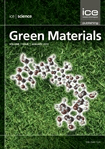
Green Materials
Scope & Guideline
Pioneering research at the intersection of sustainability and materials.
Introduction
Aims and Scopes
- Sustainable Material Development:
The journal emphasizes the development of materials that are environmentally friendly, utilizing renewable resources to reduce reliance on fossil fuels and non-renewable materials. - Innovative Processing Techniques:
Research on novel processing methods that enhance the performance and sustainability of materials, including techniques such as 3D printing, laser sintering, and green synthesis. - Biocomposites and Biopolymers:
A significant focus on the utilization of natural fibers and biopolymers, exploring their mechanical properties and potential applications in various industries, including packaging and construction. - Waste Utilization and Recycling:
Studies on transforming waste materials into valuable resources, promoting circular economy principles by recycling and repurposing industrial and agricultural by-products. - Nanomaterials and Their Applications:
Exploration of nanotechnology in materials science, including the synthesis and application of nanomaterials for enhanced performance in various fields such as electronics, medicine, and environmental remediation.
Trending and Emerging
- Green Synthesis Techniques:
There is a growing trend in utilizing green chemistry principles for the synthesis of materials, including the development of eco-friendly synthesis methods that minimize harmful by-products. - Functionalized Biocomposites:
Research on biocomposites that incorporate functional additives or treatments to enhance properties such as flame retardancy, antibacterial activity, and mechanical strength is increasingly prominent. - Smart and Adaptive Materials:
The emergence of smart materials that respond to environmental stimuli is gaining traction, with studies focusing on their applications in various sectors, including construction and electronics. - Circular Economy Practices:
An increasing number of publications emphasize the importance of circular economy practices, exploring innovative methods for waste reduction, recycling, and sustainable resource management. - Nanotechnology in Material Science:
The application of nanotechnology in developing advanced materials is trending, with a focus on enhancing material performance, functionality, and environmental sustainability.
Declining or Waning
- Traditional Synthetic Polymers:
There is a noticeable decrease in research related to conventional synthetic polymers, as the journal shifts its focus toward more sustainable alternatives and biodegradable options. - Conventional Energy Materials:
Research on materials primarily associated with fossil fuel energy sources is declining, as the journal increasingly prioritizes renewable energy solutions and sustainable material innovations. - Non-Biodegradable Composites:
The emphasis on non-biodegradable composites is waning, with fewer studies exploring their properties and applications, in favor of biodegradable and eco-friendly composite materials.
Similar Journals

CELLULAR POLYMERS
Unveiling the Potential of Cellular PolymersCELLULAR POLYMERS, published by SAGE Publications Ltd, is a leading journal dedicated to the exploration and advancement of polymer science, particularly within the realms of organic chemistry and materials science. With an ISSN of 0262-4893 and E-ISSN of 1478-2421, this journal has been a critical resource for researchers and professionals since its inception in 1982, continuously evolving to retain its relevance in an ever-advancing field. Currently, it ranks in the Q3 quartile for both Organic Chemistry and Polymers and Plastics, reflecting its focused contributions to these disciplines. Despite accessing content through subscription, the journal’s indexed visibility in databases such as Scopus, with a percentile ranking of 41st in its category, highlights its significance in the academic community. CELLULAR POLYMERS serves as a platform for innovative research and developments in polymer processing, characterization, and applications, aiming to foster interdisciplinary collaborations and knowledge dissemination among scholars, practitioners, and students alike.

Vietnam Journal of Chemistry
Unveiling Cutting-Edge Discoveries in ChemistryVietnam Journal of Chemistry, published by WILEY, is a prominent academic journal that serves as a platform for the dissemination of innovative research in the field of chemistry. With its ISSN 0866-7144 and E-ISSN 2572-8288, this journal has made a significant impact on the global scientific community, evidenced by its 2023 Scopus ranking as #274 in the General Chemistry category and a commendable percentile of 32nd. The journal, categorized in the Q3 quartile for miscellaneous chemistry subjects, aims to foster communication among chemists from Vietnam and around the world, encouraging collaboration and the exchange of cutting-edge knowledge. While it currently does not offer Open Access options, the Vietnam Journal of Chemistry is committed to contributing valuable insights from its coverage years spanning from 2018 to 2024, making it a worthy resource for researchers, professionals, and students dedicated to advancing the field of chemistry. Based in the United Kingdom, it stands as a testament to the vibrant research endeavors emerging from Vietnam and beyond.

Journal of Polymer & Composites
Driving the Evolution of Polymer Science Through Scholarly Excellence.Journal of Polymer & Composites, with ISSN 2321-8525 and E-ISSN 2321-2810, is an esteemed academic journal published by STM JOURNALS, dedicated to the advancement of knowledge in the rapidly evolving fields of polymer science and composite materials. The journal serves as a pivotal platform for researchers and professionals, offering cutting-edge research articles, reviews, and case studies that explore innovative developments and applications in polymer chemistry, material science, and engineering. Although currently lacking an impact factor citation, the journal aims to foster dialogue among academia and industry partners, addressing the latest trends and breakthroughs that drive the field forward. With a commitment to scholarly excellence, the Journal of Polymer & Composites is positioned as an essential resource for enhancing the understanding of polymer composites and their multifaceted applications. Notably, STM JOURNALS' reputation for quality publications underscores the journal’s importance in facilitating impactful research and educational initiatives worldwide.

Materials Research Express
Advancing the frontiers of materials science.Materials Research Express is a leading open-access journal published by IOP Publishing Ltd, situated in the United Kingdom. Since its establishment in 2014, the journal has become an essential platform for researchers and professionals in the field of materials science, spanning several critical domains including biomaterials, metals and alloys, polymers, and electronic materials. With an open-access model adopted in 2020, Materials Research Express ensures that cutting-edge research is accessible to a global audience, enriching the dissemination of knowledge within the scientific community. The journal boasts impressive Scopus rankings, with a commendable position in various categories, such as 45th in Metals and Alloys and 51st in Surfaces, Coatings, and Films. This positions it well in the competitive landscape of materials science, fostering innovative discussions on material properties and applications. As the field continues to evolve, Materials Research Express aims to provide high-quality research and insights that address contemporary challenges and emerging technologies, making it an indispensable resource for academics and industry professionals alike.
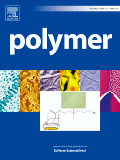
POLYMER
Connecting Scholars through Cutting-edge Polymer SciencePOLYMER, an esteemed journal published by Elsevier Science Ltd, stands at the forefront of polymer science, presenting cutting-edge research that encompasses the realms of Materials Chemistry, Organic Chemistry, and Polymers and Plastics. With a remarkable impact factor reflecting its significance in the academic community, POLYMER has been a vital resource since its inception in 1960, contributing to a converged body of knowledge through to 2024. Rated Q1 in all relevant categories as of 2023, and boasting impressive Scopus rankings, this journal not only facilitates advanced discussions in polymer synthesis, characterization, and applications but also serves as a critical platform for collaborative research among scholars, professionals, and students. While it offers content primarily via subscription, POLYMER remains dedicated to fostering innovation and excellence in the field, making it an essential read for anyone passionate about polymer science.

Accounts of Materials Research
Catalyzing interdisciplinary collaboration in materials research.Accounts of Materials Research is a premier journal published by the American Chemical Society, focusing on the multidimensional field of materials science. With a robust impact factor and a commitment to open-access research, it serves as a vital platform for leading-edge discoveries from 2020 to 2024. The journal has rapidly ascended to the top quartile in multiple categories, including Chemical Engineering, Materials Chemistry, and Polymers and Plastics, demonstrating its significant influence within the academic community. Recognized by Scopus as a key resource—with remarkable rankings that place it in the 95th percentile of its field—Accounts of Materials Research is devoted to publishing high-quality, innovative research that addresses critical challenges in materials development and implementation. This journal is essential for researchers, professionals, and students seeking to stay informed about the latest advancements and collaborative opportunities within the interdisciplinary landscape of materials science.

Green Chemistry Letters and Reviews
Shaping the future of chemistry with sustainability in mind.Green Chemistry Letters and Reviews is a premier Open Access journal published by TAYLOR & FRANCIS LTD, dedicated to advancing the field of green chemistry through the dissemination of high-quality research and innovative reviews. With a focus on sustainable practices and environmental impacts, this journal positions itself at the nexus of chemistry and environmental science, achieving impressive rankings in both categories—Q1 in Chemistry (miscellaneous) and Q1 in Environmental Chemistry as of 2023. This esteemed publication, based in the United Kingdom, not only promotes critical research but also encourages accessibility, having been an Open Access platform since 2012. With a robust H-Index reflecting its academic influence, Green Chemistry Letters and Reviews serves as an essential resource for researchers, professionals, and students seeking to engage with cutting-edge developments in green chemistry from 2007 onwards, continuing its impactful journey into 2024 and beyond.
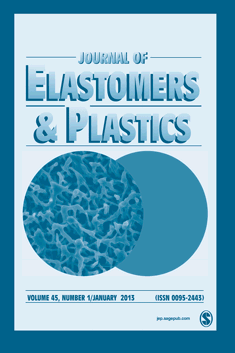
JOURNAL OF ELASTOMERS AND PLASTICS
Advancing the Frontiers of Elastomers and Plastics ResearchJOURNAL OF ELASTOMERS AND PLASTICS is a prestigious peer-reviewed journal published by SAGE Publications Ltd that has been at the forefront of material science research since its inception in 1969. Focusing on the fields of Materials Chemistry and Polymers and Plastics, this journal aims to disseminate cutting-edge research that explores the synthesis, characterization, and application of elastomers and plastics in various industries. With a position in the Q2 category for both Materials Chemistry and Polymers and Plastics as of 2023, it showcases significant contributions that push the boundaries of knowledge in these vital areas. Although it does not offer Open Access options, the journal continues to be regarded for its rigorous standards and comprehensive peer-review process. Researchers, professionals, and students in the field will find valuable insights and essential methodologies that can drive innovation and enhance practical applications in elastomers and plastics.
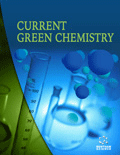
Current Green Chemistry
Exploring innovative pathways for a greener future.Current Green Chemistry, published by Bentham Science Publishers, is a pivotal scholarly resource devoted to advancing the field of green chemistry. With ISSN 2213-3461 and E-ISSN 2213-347X, this journal serves as a crucial platform for researchers and professionals to explore innovative and sustainable practices within the chemical sciences. The journal has demonstrated significant recognition, evidenced by its categorization in the third quartile (Q3) across various specializations including Analytical Chemistry and Inorganic Chemistry, and even a fourth quartile (Q4) in Organic Chemistry, according to the latest Scopus metrics. This indicates a growing influence in relevant fields, making it a valuable reference for contemporary environmental initiatives. The journal's accessible nature, although not open access, ensures researchers can still engage with high-quality, peer-reviewed content. Spanning an impressive converged period from 2019 to 2024, Current Green Chemistry is committed to enhancing the visibility of groundbreaking research that aligns with sustainable development objectives, making it an essential resource for anyone interested in the future of chemistry.
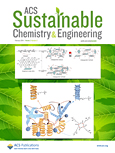
ACS Sustainable Chemistry & Engineering
Advancing sustainability through innovative chemistry.ACS Sustainable Chemistry & Engineering is a premier journal published by the American Chemical Society, dedicated to advancing knowledge and innovation in the fields of sustainable chemistry and engineering. With an impressive impact factor and a consistent ranking in the Q1 category across various disciplines such as Chemical Engineering, Chemistry, Environmental Chemistry, and Renewable Energy, this journal serves as a vital resource for researchers, professionals, and students alike. Since its inception in 2013, the journal has been committed to publishing high-quality, peer-reviewed articles that address the critical challenges of sustainability in chemistry and engineering. With no open-access option currently available, the journal emphasizes the importance of premium scholarly communication. As the field continues to evolve, ACS Sustainable Chemistry & Engineering remains at the forefront of providing cutting-edge research that impacts our understanding and application of sustainable practices in the chemical sciences.